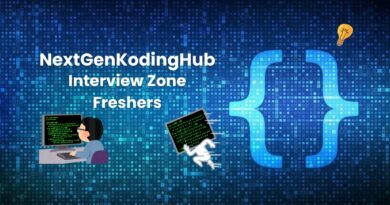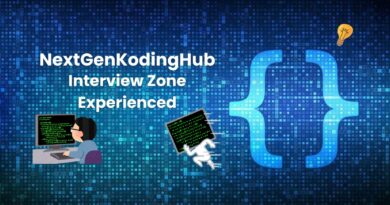Live Coding and Whiteboard Challenges
Interview Focus: Live Coding and Whiteboard Challenges
Live Coding and Whiteboard Challenges: Top Interview Preparation Tips and Questions
In today’s technical interviews, Live Coding and Whiteboard Challenges play a pivotal role in evaluating candidates’ problem-solving and coding abilities. These challenges test not only your knowledge of algorithms and data structures but also your communication skills, logical thinking, and approach to problem-solving in real-time. Understanding how to approach these challenges can make the difference between success and failure.
This guide presents over 30 common questions and detailed strategies related to Live Coding and Whiteboard Challenges. Whether you are a fresher or an experienced candidate, mastering these will significantly boost your confidence and performance during interviews.
1. What are Live Coding and Whiteboard Challenges?
Live Coding refers to writing code in real-time during an interview, often on a shared online platform or a physical computer. Whiteboard Challenges involve solving problems by writing code or algorithms on a whiteboard without a compiler. Both assess your coding skills, problem-solving ability, and how you think aloud while tackling problems.
2. How should you prepare for Live Coding and Whiteboard Challenges?
Preparation involves mastering algorithms and data structures, practicing common coding problems, and simulating interview conditions. Regularly solve problems on platforms like LeetCode, HackerRank, and CodeSignal. Practice explaining your thought process clearly, as communication is crucial.
3. What is the best way to approach a Live Coding challenge?
Start by understanding the problem thoroughly. Clarify any doubts with the interviewer. Next, discuss your approach before writing code. Write clean, modular code incrementally, testing parts mentally or with test cases if possible. Finally, review your solution and optimize if time permits.
4. How do you handle pressure during Live Coding and Whiteboard Challenges?
Staying calm is vital. Take a deep breath before starting, break the problem into smaller parts, and focus on solving one step at a time. If you get stuck, communicate your thought process and ask clarifying questions. Interviewers appreciate your problem-solving approach more than perfection.
5. Can you explain how to write clean and efficient code during Live Coding?
Use meaningful variable names, avoid redundant code, and follow consistent indentation. Focus on readability as well as efficiency. Write functions for repeated tasks and use comments to explain complex logic when appropriate.
6. What are some common data structures to know for Live Coding and Whiteboard Challenges?
Essential data structures include arrays, linked lists, stacks, queues, trees, graphs, hash tables, heaps, and tries. Understanding their properties, operations, and use cases will help you choose the right tool for the problem.
7. How important are algorithms in Live Coding and Whiteboard Challenges?
Algorithms are central to solving problems efficiently. Familiarize yourself with sorting, searching, recursion, dynamic programming, backtracking, greedy algorithms, and graph traversal techniques like BFS and DFS.
8. Describe how to approach a problem that seems unfamiliar during a whiteboard challenge.
Break the problem down into smaller components, identify similar known problems, and try to build a brute-force solution first. Then, discuss possible optimizations. Showing logical thinking and incremental improvement impresses interviewers.
9. How do you communicate effectively during Live Coding and Whiteboard Challenges?
Narrate your thought process clearly, explain your reasoning for choosing data structures and algorithms, and talk through your code line by line. This transparency helps interviewers understand your problem-solving approach.
10. What is the role of test cases in Live Coding and Whiteboard Challenges?
Test cases validate your solution. Always test with sample inputs, including edge cases like empty inputs, very large numbers, or unusual values. If possible, walk through how your code handles these cases.
11. How do you optimize your solution during Live Coding?
After writing a working solution, analyze its time and space complexity. Discuss potential bottlenecks and suggest improvements, like using more efficient algorithms or data structures, or eliminating unnecessary operations.
12. What mistakes should be avoided during Live Coding and Whiteboard Challenges?
Avoid rushing to write code without understanding the problem, neglecting edge cases, ignoring code readability, or staying silent without explaining your approach. Also, don’t panic if you make mistakes; instead, correct and learn from them.
13. Can you share a sample Live Coding problem and solution?
Sure! Here is a classic example:
Problem: Reverse a String
Write a function that reverses a given string.
|
1 2 3 4 5 |
def reverse_string(s): return s[::-1] # Example usage print(reverse_string("hello")) # Output: "olleh" |
14. What is the difference between Live Coding and Whiteboard Challenges?
Live Coding usually happens on a computer with a code editor and compiler, enabling real-time testing. Whiteboard Challenges involve no compiler or runtime, requiring you to write correct and logical code manually. Both demand clear thinking and communication but differ in environment.
15. How do you deal with time constraints during Live Coding and Whiteboard Challenges?
Prioritize writing a correct, simple solution first. Avoid overcomplicating early on. If time permits, then optimize. Communicate your plan to the interviewer, showing that you value correctness over premature optimization.
16. How important is explaining your thought process during these challenges?
Explaining your thought process is crucial. It demonstrates your analytical skills and helps interviewers identify your strengths and areas to guide you. Silent coding often leaves interviewers unsure about your understanding.
17. How can you practice effectively for Live Coding and Whiteboard Challenges?
Practice coding on a whiteboard or paper to simulate interview conditions. Participate in mock interviews, time yourself solving problems, and explain your reasoning out loud. Regular practice builds confidence and fluency.
18. How do you tackle algorithmic complexity questions?
Start by defining the input size (n) and analyze the operations step-by-step. Discuss the Big O notation for time and space. Interviewers appreciate candidates who understand the efficiency and trade-offs of their solutions.
19. How do you handle situations when you don’t know the answer?
Stay calm and think aloud. Break down the problem, suggest a brute-force approach, and express willingness to learn. Asking clarifying questions shows engagement and problem-solving skills.
20. What are some tools to simulate Live Coding and Whiteboard Challenges?
Platforms like LeetCode, HackerRank, CodeSignal, and Pramp offer coding challenges and mock interviews. Practicing on physical whiteboards or paper helps get comfortable with no code execution environment.
21. How do you handle syntax errors during Live Coding?
Stay calm and fix errors methodically. Use your knowledge of language syntax, and if stuck, communicate what you think the problem might be. Interviewers often focus on logic rather than minor syntax mistakes.
22. What role does problem decomposition play in Live Coding and Whiteboard Challenges?
Breaking down a complex problem into smaller parts simplifies the solution process and makes debugging easier. It also demonstrates clear thinking to the interviewer.
23. How can you showcase leadership during Live Coding?
Take initiative by clarifying requirements, suggesting improvements, and collaborating with the interviewer. Show confidence in your approach and adaptability to feedback.
24. What are some behavioral tips to succeed in Live Coding interviews?
Maintain eye contact, stay positive, don’t hesitate to ask for hints, and show appreciation for feedback. These behaviors create a collaborative atmosphere.
25. How do you handle questions about design patterns or system design in coding interviews?
If asked, briefly describe relevant design patterns and how they solve common problems. Incorporate best practices in your code to reflect understanding.
26. What is the importance of practicing mock Live Coding sessions?
Mock sessions help simulate pressure and improve time management, communication, and problem-solving skills in a realistic setting.
27. How do you review your code after completing a Live Coding challenge?
Walk through your solution, check for edge cases, and discuss potential improvements or alternative approaches with the interviewer.
28. How important is domain knowledge in Live Coding and Whiteboard Challenges?
Domain knowledge can help tailor solutions and understand problem context better but most interviews focus primarily on general coding and algorithm skills.
29. How to improve problem-solving speed?
Regular practice, learning common problem patterns, and building a mental library of algorithms improve speed and accuracy during interviews.
30. Final Tips for Acing Live Coding and Whiteboard Challenges
Consistency in practice, clear communication, breaking down problems logically, and staying calm under pressure are your keys to success. Remember, interviewers value how you approach problems as much as your final solution.
Bonus: Additional Practice Question
Problem: Write a function to check if a string has all unique characters.
|
1 2 3 4 5 6 7 8 9 10 11 |
def has_unique_chars(s): seen = set() for char in s: if char in seen: return False seen.add(char) return True # Example usage print(has_unique_chars("abcde")) # Output: True print(has_unique_chars("hello")) # Output: False |



